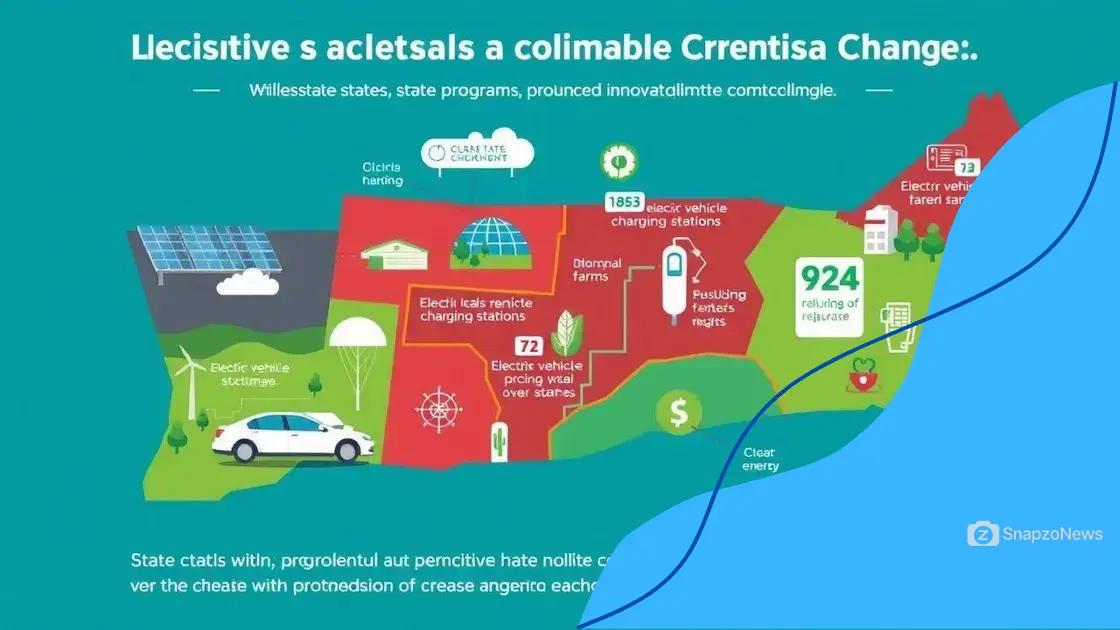Efforts to address climate change at the state level

Efforts to address climate change at the state level involve innovative policies, community engagement, and technological advancements aimed at reducing emissions and promoting sustainability through collaboration and targeted initiatives.
Efforts to address climate change at the state level play a pivotal role in combating environmental issues. From innovative policies to community involvement, states are taking varied actions that impact us all. Curious about what’s being done in your area?
Understanding state-level climate initiatives
Understanding state-level climate initiatives is essential in tackling climate change effectively. These initiatives form the backbone of local actions aimed at reducing carbon emissions and promoting sustainability.
States are often at the forefront of implementing climate solutions tailored to their unique challenges and resources. By exploring what different states are doing, we can learn valuable lessons that can be replicated elsewhere.
Key State Initiatives
Many states have rolled out significant programs designed to address climate change. These initiatives focus on various aspects, including energy efficiency, renewable energy, and conservation efforts. Here are a few notable examples:
- Cap-and-trade programs to limit greenhouse gas emissions.
- Incentives for adopting solar and wind energy.
- Investment in public transportation to reduce automobile dependency.
Moreover, public awareness and community involvement play critical roles. For instance, states that actively engage their communities often see a greater impact from their environmental programs. Educational campaigns can help individuals understand their role in combating climate change, encouraging behavior changes that support sustainability.
Collaboration Among States
Another crucial factor is collaboration among states. Many states participate in regional partnerships to share knowledge and resources. This collaboration enhances the effectiveness of their climate initiatives. By working together, states can address cross-border issues and learn from each other’s successes and setbacks.
In addition to state governments, partnerships with local governments and organizations are vital. They can implement initiatives more effectively at the grassroots level, ensuring that solutions are relevant and impactful in local communities.
Ultimately, understanding state-level climate initiatives is not just about recognizing efforts but also about fostering a culture of sustainability through shared knowledge and partnerships. These initiatives are critical for building resilient communities and navigating the ongoing impacts of climate change.
Key policies driving state-level change
Key policies driving state-level change are at the heart of effective climate action. These policies are designed to create a framework for reducing emissions and promoting sustainability in various sectors.
States have implemented a variety of approaches, which can serve as models for others. Some policies focus on energy efficiency, while others emphasize renewable energy sources. This diversity allows states to tailor their strategies to fit local needs.
Renewable Energy Standards
Many states have adopted renewable energy standards that require a certain percentage of energy to come from renewable sources. These standards encourage investments in solar, wind, and other clean technologies. The following benefits come from these policies:
- Increased job creation in the renewable energy sector.
- Decreased reliance on fossil fuels.
- Improved public health due to reduced air pollution.
By setting clear targets, states not only promote green energy but also provide businesses with certainty to invest confidently in clean technologies.
Energy Efficiency Programs
Energy efficiency programs also play a crucial role in state policy. These initiatives can include rebates for energy-efficient appliances and incentives for homeowners to make improvements. Such policies benefit consumers and reduce stress on the energy grid.
Investing in energy efficiency can lead to significant savings over time, both for residents and for state budgets. Programs that focus on reducing energy consumption contribute greatly to lowering emissions.
Moreover, states are increasingly adopting policies around transportation emissions. Regulations that aim to reduce vehicle emissions are essential in combating climate change. By promoting electric vehicles and better public transportation, states can significantly impact overall emissions.
Ultimately, these key policies not only support state-specific goals but also contribute to a national and global effort to address climate change. By investing in sustainable solutions, states can make substantial progress toward a cleaner future.
Case studies of successful state programs

Case studies of successful state programs provide valuable insights into effective climate action. These programs showcase how various states have implemented innovative solutions and achieved significant results.
One notable example is California’s cap-and-trade program. This initiative has successfully reduced greenhouse gas emissions while promoting economic growth. By setting a limit on emissions and allowing companies to trade allowances, California has created a financial incentive for businesses to decrease their carbon footprints.
Massachusetts’ Clean Energy Initiative
Another strong example is Massachusetts, which has focused on expanding clean energy through aggressive solar policies. Their Solar Massachusetts Renewable Target (SMART) program aims to increase solar installations across the state. This initiative not only boosts renewable energy use but also creates jobs in the clean energy sector.
States like New York have launched programs to promote energy efficiency. The New York State Energy Research and Development Authority (NYSERDA) implements various projects that provide incentives for homeowners and businesses to adopt energy-saving technologies. Such initiatives have led to measurable reductions in energy consumption.
Oregon’s Clean Fuels Program
Oregon’s Clean Fuels Program aims to reduce the carbon intensity of transportation fuels over time. By promoting alternative fuels and investing in infrastructure for electric vehicles, Oregon is making strides in decreasing transportation emissions. This program serves as a model for other states looking to tackle emissions from the transportation sector.
These case studies show that successful state programs often involve collaboration between government, businesses, and communities. By working together, stakeholders can create effective strategies that address local climate challenges. Each of these states demonstrates the potential of targeted climate policies to drive positive change.
Community engagement in climate action
Community engagement in climate action is essential to drive meaningful change at the local level. When communities come together, they can address environmental issues more effectively. Engaging residents fosters a shared sense of responsibility and empowers individuals to take part in climate initiatives.
Many successful programs rely on strong community involvement. For example, neighborhood clean-up events not only improve local spaces but also raise awareness about the importance of maintaining a clean environment. Communities that work together create a stronger bond and often see a positive impact on their local ecosystem.
Educational Workshops and Programs
Organizing educational workshops can be a great way to engage the community. These sessions help people understand the science behind climate change and the role they can play in combating it. Workshops may cover topics like:
- Energy conservation tips for households.
- How to reduce waste and recycle effectively.
- Local conservation efforts and how to get involved.
By sharing knowledge, communities inspire each other to adopt sustainable practices. This collective action can lead to lasting changes in behavior and a greater commitment to environmental stewardship.
Local Advocacy Initiatives
Local advocacy initiatives also play an important role in climate action. Residents can come together to voice their concerns and promote policies that benefit the environment. For instance, campaigns to lobby local governments for more green spaces or better public transportation can make a significant difference.
Such initiatives not only improve the quality of life but also show that communities can influence decision-making processes. When people advocate for change, they create a powerful platform that amplifies their voices and encourages local leaders to act.
By fostering community engagement, we can build a more resilient society poised to face climate challenges. The combined efforts of individuals and groups lead to innovative solutions that benefit everyone. Communities that actively participate in climate action enjoy enhanced social bonds and a sustainable future.
Future challenges and opportunities
Future challenges and opportunities in addressing climate change at the state level are rapidly evolving. As climate-related issues grow more complex, states face new obstacles that require innovative solutions. However, these challenges also come with the chance to implement effective strategies that can lead to long-term benefits.
One major challenge is the need for adequate funding. Many states struggle to secure financial resources for climate initiatives. However, this opens the door for opportunities through collaboration with private sectors or federal grants. By forming partnerships, states can leverage additional resources to support their climate action plans.
Technological Advancements
Technological advancements also play a pivotal role in combating climate change. With automation and smart technologies, states can implement more efficient energy systems. For instance, smart grids enable better management of energy demands and reduce waste. This not only addresses emission reductions but also helps consumers save on their energy bills.
- Investments in renewable energy sources are crucial for future energy security.
- Adopting electric vehicles could significantly cut transportation emissions.
- Developing new materials can enhance energy efficiency in construction.
The transition to a clean energy economy is another pressing opportunity. States can take the lead in transforming their energy sectors by investing in renewable energy sources such as wind and solar power. This shift not only helps combat climate change but also creates jobs and stimulates the economy.
Social Equity Considerations
Addressing social equity is essential when planning future climate action. Low-income communities often bear the brunt of environmental issues. Ensuring that all communities have access to clean energy and resources will be a key goal. By targeting equity in climate policies, states can create more inclusive and effective solutions.
Lastly, effective communication will be vital for overcoming challenges and seizing opportunities. States should engage with the public to raise awareness and foster participation. By informing and involving the community, states can build widespread support for climate initiatives, ensuring their success moving forward.
FAQ – Frequently Asked Questions about State-Level Climate Change Efforts
What are state-level climate initiatives?
State-level climate initiatives are programs and policies established by state governments to address climate change, reduce emissions, and promote sustainability.
How can communities engage in climate action?
Communities can engage in climate action by participating in local workshops, advocacy initiatives, and community clean-up events, fostering a sense of responsibility.
What role does technology play in climate solutions?
Technology plays a crucial role in climate solutions through innovations such as smart grids, renewable energy, and energy-efficient systems that reduce pollution.
What challenges do states face in combating climate change?
States face challenges like funding constraints, the need for equitable policies, and the complexity of implementing effective climate strategies, but these also present opportunities for growth.
